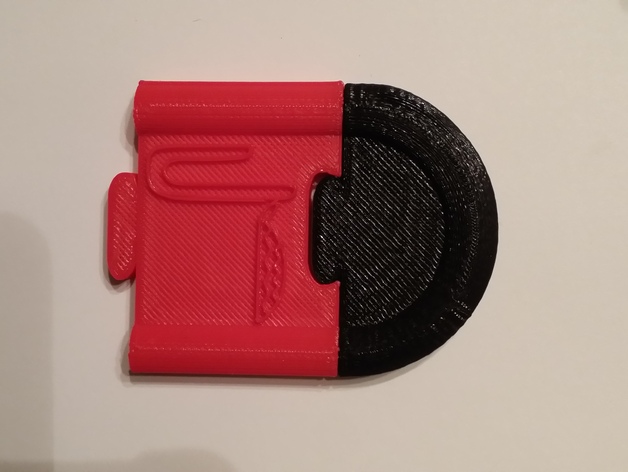
Real World Measurements and Tolerances
thingiverse
The purpose of this lesson is to show you that by taking a few items into consideration you can save yourself time, frustration, and filament by making a few calculations in sizing your parts. Print Settings Printer Brand: MakerBot Printer: MakerBot Replicator 2 Rafts: No Supports: No Resolution: Standard Infill: 10% How I Designed This The 3D printed parts were designed in Tinkercad. Overview and Background Participating teams of three or four students are provided with a bag of printed 3D parts and pins. Each team will be taking measurements of printed parts and depending of the type of “Fit” required calculate the corresponding values. Objectives Through this lesson, students will: Learn design concepts. Learn teamwork. Learn problem solving techniques. Learn about simple machines and tolerances. Audience ages 10-14 Subjects Robotics Design Technology Physical Science Skills Learned (Standards) National Science Education Standards Grades 5-8 (ages 10 – 14) CONTENT STANDARD B: Physical Science: As a result of their activities, all students should develop an understanding of Motions and forces, Transfer of energy National Science Education Standards Grades 9-12 (ages 14 – 18) CONTENT STANDARD B: Physical Science: As a result of their activities, all students should develop understanding of Motions and forces, Interactions of energy and matter CONTENT STANDARD E: Science and Technology: As a result of activities, all students should develop Abilities of technological design, Understandings about science and technology Standards for Technological Literacy – All Ages Lesson Plan and Activity For the purpose of this lesson we will be using the following conventions: Snug fit = 98% of original size Loose fit = 96% of original size When trying to fit 2 real world parts together you have probably noticed that if you try to put a round peg into a round hole they almost never fit. The purpose of this lesson is to show you that by taking a few items into consideration you can save yourself time, frustration, and filament by making a few calculations in sizing your parts. First determine what kind of “Fit” do you need. Do you need something to fit snuggly with little wiggle room or do you need a loose “Fit” where the connecting object is free to spin in the socket. After determining fit we need to use a set of calipers and measure the inner diameter of the piece that we are going to try and fit into. Next multiply that number, ie 30 mm by .98 or .96 respectively to get the fit that you are looking for. So for the above example:: To get a snug fit you would make the diameter of the inserting part 30.98=29.4mm To get a loose fit you would make the diameter of the inserting part 30.96=28.8mm Note: If you are using Tinkercad this can be done with the use of the Ruler tool under Helpers from the right side of the screen. This will allow you to input exact measurements for your parts. This procedure should work pretty good for you if you are working with printed parts trying to fit with printed parts. But let's say that you have an item such as a broken push button and you want to print a replacement. The above procedure probably will not work for you as well because of one important variable in 3D printed parts which is shrinkage. This variable is completely dependent on the type of material you are using to print your replacement part out of. We will be taking the 2 most prevalent types of filament into consideration, ABS and PLA. Because of the chemical composition of each type of plastic their thermal and elastic properties vary widely. Suffice to say the average shrinkage of PLA is typically in the range of .3 to 2 % depending on manufacturer. For Makerbot filament I usually get a shrinkage rate of about .5%, so if we take this into account and decide that we need a snug fit our calculation for a 30mm hole would be the following: (30*.98)+(30*.98*.005)=(29.4)+(29.4)*.005=29.4+.147=29.55 This basically says that we first find the final size of the object we want taking a loose or snug fit into account and then adding the shrinkage rate. To determine the shrinkage rate of the material you are using print out a 5mmX5mmX50mm rod and using your calipers measure the printed object.. If it is say 49.2mm then you take that difference and double it to get the total shrinkage for that filament. So for our example that would be: (50-49.2)(2)=(.8)(2)=1.6% shrinkage rate With this information in hand you should be able to design printed parts that fit the way you want them to. Materials Needed To prepare for this lesson you will need the following supplies: Various printed appendage pieces Set of calipers Calculator Duration of Lesson 60 minutes Rubric and Assessment These reflective questions will help assess student understanding: Based on calculations how close were your “Fits”? What is one thing you would change about your calculations based on your experience? Are there algebraic and physical principles that can be applied to this activity? How would you modify the percentages to create a better “Fit”? References TryEngineering (www.tryengineering.org) Design Your Own Robot (www.mos.org/robot/robot.html) FIRST Robotics Competition (www.usfirst.org)
With this file you will be able to print Real World Measurements and Tolerances with your 3D printer. Click on the button and save the file on your computer to work, edit or customize your design. You can also find more 3D designs for printers on Real World Measurements and Tolerances.
